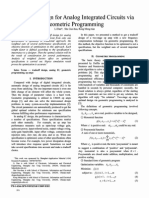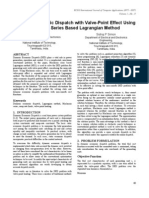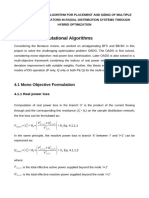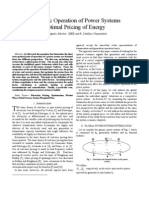Modelling Network Constrained Economic Dispatch Problems
Modelling Network Constrained Economic Dispatch Problems
Uploaded by
Nguyễn HồngCopyright:
Available Formats
Modelling Network Constrained Economic Dispatch Problems
Modelling Network Constrained Economic Dispatch Problems
Uploaded by
Nguyễn HồngOriginal Description:
Original Title
Copyright
Available Formats
Share this document
Did you find this document useful?
Is this content inappropriate?
Copyright:
Available Formats
Modelling Network Constrained Economic Dispatch Problems
Modelling Network Constrained Economic Dispatch Problems
Uploaded by
Nguyễn HồngCopyright:
Available Formats
1
Modelling Network Constrained Economic Dispatch
Problems
Rodrigo Palma-Benhke,
z
Senior Member, IEEE, Andy Philpott
y
Member, IEEE, Alejandro Jofr
and Marcelo
Corts-Carmona
]
, Graduate Student, IEEE,
AbstractThe behaviour of DC Load-ow formulations when
they are used in economic dispatch and nodal pricing models is
discussed. It is demonstrated that non-negative prices in these
models are sufcient to guarantee global optimality of any local
optimum, even if the feasible region is not convex, and so a
negative nodal price is an indicator of a possible loss in optimality.
It is also discuss the possible effect that negative prices might
have on algorithms that assume this convexity.
Index TermsConvex Optimization, Economic Dispatch,
Quadratic Programming, Linear Programming.
I. INTRODUCTION
In power markets there is an increasing need for improv-
ing the representation of high-voltage transmission networks
in order to better support market design alternatives, price-
formation mechanisms, and for general operation and planning
decisions. In most cases, this process involves the denition
of more complex mathematical models. Different optimization
approaches based on DC Load-ow formulations are exten-
sively used in this eld [1][4].
In this paper we study the behaviour of DC Load-ow
formulations when used in economic dispatch and nodal
pricing models. Our focus is on instances of these models in
which negative prices are observed at some nodes. A negative
price at a node indicates a situation in which the system cost
can be reduced by more consumption of power at the node.
When there is a free disposal of power at this node, a simple
economic argument shows that the nodal price must be non-
negative. So negative prices can only occur when ow balance
constraints in the dispatch model are modeled as equations.
When the DC-load ow model does not include line losses,
it is a linear program, which is easily solved using standard
software [5], [6]. Linear programs are convex optimization
problems, and enjoy all their desirable properties. Although
negative prices may occur in these models, their existence need
not be a matter of any concern. On the other hand, when losses
are modeled as quadratic functions of the line ow, it is well
known that (without free disposal at the nodes) the feasible
z
Department of Electrical Engineering, University of Chile, Avenida
Tupper 2007, Santiago, Chile - Tel: 56-2- 9784203 - email: rod-
palma@cec.uchile.cl.
y
Electric Power Optimization Centre, Department of Engineering Science,
University of Auckland, - email: a.philpott@auckland.ac.nz.
Center of Mathematical Modelling, University of Chile, Avenida
Blanco Encalada 2120, Santiago, Chile - Telephone: 56-2-9784454 - email:
ajofre@dim.uchile.cl.
]
Department of Electrical Engineering, University of Chile and Uni-
versity of Antofagasta, Avenida Tupper 2007, Santiago, Chile, email:
mcortes@uantof.cl.
region of the dispatch model is no longer convex [7]. This
means that the benets of convex optimization are no longer
guaranteed.
In this paper we investigate the extent to which this loss of
convexity is material in solving realistic dispatch problems.
We demonstrate that non-negative prices are sufcient to
guarantee global optimality, even if the feasible region is
not convex, and so a negative nodal price is an indicator of
a possible problem for optimization software. In particular,
we show that linear programming software that approximates
losses by piecewise linear functions will not represent losses
properly as it becomes more accurate. Quadratic programming
software that assumes positive denite Hessian matrices may
also encounter problems in solving such problems. Finally
nonlinear optimization software that yields at best a local
optimum may not give a global optimal solution when prices
are negative.
The paper is laid out as follows. In the next section, we
give some general mathematical results that can be applied to
the dispatch problem. A general mathematical formulation of
the economic dispatch problem is then presented in Section
III, and we present a three-busbar model to illustrate the
formulation, and to serve as an example of some of the
difculties we describe. We rst show in Section IV how
linear programming software might fail when applied to this
problem. In Section V we compute the Hessian matrix of the
Lagrangian with respect to the ow-balance constraints, and
show how this might fail to be positive semi-denite with
negative prices. In Section VI a nonconvex six-busbar example
is described and used to illustrate how a negative price might
be an indicator of a local optimum solution. Finally, Section
VII presents the conclusions of the work.
II. PRELIMINARIES
Consider the general optimization problem
1(n) : min
i
/
i
(
i
)
s.t. q
i
()) +
i
= n
i
, i = 1, 2, . . . , :
) +1 = /,
) 1, Q.
(1)
where each /
i
is a convex function and each q
i
is a concave
function; and 1 are j: and j: real matrices; / lies in
1
p
; and 1 and Q are convex sets in 1
m
and 1
n
respectively.
2
We dene the following relaxation of 1(n):
G(n) : min
i
/
i
(
i
)
s.t. q
i
()) +
i
_ n
i
, i = 1, 2, . . . , :
) +1 = /,
) 1, Q.
(2)
Assume that every feasible point of 1(n) and G(n) satisies
a constraint qualication (see e.g. [8]). Let `
i
(1), i =
1, 2, . . . , :, be the Lagrange multipliers from the rst set of
constraints for 1 (and let `
i
(G) be dened similarly).
Proposition 1: `
i
(G) _ 0, i = 1, 2, . . . , :.
Proof: See [8].
Proposition 2: If `
i
(1) _ 0, i = 1, 2, . . . , : for a locally
optimal solution to 1(n), then this is also optimal for G(n).
Proof: Suppose that (
, )
) solves 1(n), with `
i
(1) _
0, i = 1, 2, . . . , :. Then (
, )
, `(1)) satises the Karush-
Kuhn-Tucker conditions of G(n). Since G(n) is a convex
programming problem these conditions are sufcient.
Corollary 3: A locally optimal solution to 1(n) with
`
i
(1) _ 0, i = 1, 2, . . . , : is also globally optimal.
Corollary 4: Let c
E
(n) be the optimal value of 1(n). If
`
i
(1(n)) _ 0, i = 1, 2, . . . , : for every n then c
E
(n) is
convex.
Proof: Follows from the convexity of the optimal value
of the convex programming problem G(n) (see [8]).
III. THE ECONOMIC DISPATCH PROBLEM
A. The General Case
The economic dispatch problem for an electricity generation
and transmission system is typically formulated by expressing
link ows and losses in terms of voltage angles at each bus
[2].
7 = 'i:
_
NG
i=1
C
Gi
(1
Gi
) +
ND
i=1
C
Ui
(1
Ui
)
_
:.t. (3)
k2
G
i
1
G
k
j2
N
i
_
0
i
0
j
r
ij
+
r
ij
(0
i
0
j
)
2
2r
2
ij
_
+
k2
C
i
1
U
k
=
k2
C
i
1
C
k
\i
0
i
0
j
_ r
ij
1
ij
\(i, ,)
NN
0
j
0
i
_ r
ij
1
ji
x
E
_ x
E
_ x
E
where:
G = number of generators
1 = number of demands
= number of busbars
N
i
= set of nodes adjacent to node i
G
i
= set of generators at node i
C
i
= set of demands at node i
C
Gi
= convex generation cost function,
C
Ui
= convex cost function of unserved energy.
1
Gi
= generation active power injection in per unit.
1
Ui
= unserved energy (active power) in per unit.
0
i
= voltage phase angle from node i expressed in
radians.
r
ij
= line series reactance expressed in per unit.
r
ij
= represents the equivalent resistance expressed in
per unit where rr
ij
is line series resistance expressed in
per unit.
1
Cj
= active power load expressed in per unit.
1
ij
= active power ow between nodes i and , expressed
in per unit.
1
ij
= maximum active power ow on transmission line
between nodes i and , expressed in per unit.
x
E
=
_
1
G
1
U
0
= vector of all optimization vari-
ables.
Ohmic losses 11
ij
for each transmission line can be
represented [1] by the nonlinear function
11
ij
= 2
rr
ij
rr
2
ij
+r
2
ij
(1 cos(0
i
0
j
)) (4)
that has a second-order approximation given by the quadratic
function
11
ij
-
rr
ij
rr
2
ij
+r
2
ij
(0
i
0
j
)
2
,
which on substitution of equivalent resistance r
ij
=
rrijx
2
ij
rr
2
ij
+x
2
ij
gives
11
ij
-
r
ij
(0
i
0
j
)
2
r
2
ij
.
This can be further simplied using the fact that rr
ij
r
ij
(rr
ij
= 0.25 r
ij
or less) to give
11
ij
- rr
ij
1
2
ij
=
rr
ij
r
2
ij
(0
i
0
j
)
2
. (5)
The resulting economic dispatch problem has convex cost
function, quadratic equality constraints (node balances), linear
inequality constraints and bounds for each variable. It is easy
to see by making the substitution )
ij
=
ij
xij
, i < ,, that
the economic dispatch problem is in an equivalent form to
1(n). Here the function q
i
()) takes the form of
j<i
()
ji
rij
2
)
2
ji
) +
i<j
()
ij
rij
2
)
2
ij
). It is important to note that
the economic dispatch problem can also be modeled with
nonconvex generator cost curves [9], a case that falls outside
the setting we discuss here.
B. Example 3-node system
To motivate our discussion we shall study the realistic 220
kV three-busbar system shown in Fig. 1. This case study
is based on realistic data and can be interpreted as a sub-
network of more extended power system. Here, for each line
we consider reactances r
ij
= 0.4 ,/: and equivalent resis-
tances r
ij
= 0.04 ,/: rr
ij
= 0.040408 ,/:. Using a
reference power Sb = 100 MVA, the resulting reactances and
resistances in per unit are shown in Fig. 1.
Line lengths: Line A = Line B = 121 /:, Line C = 181.5
/:.
The transmission capacity of Line C expressed in active
power is set to 1
23
= 50 '\.
3
Fig. 1. Three busbar system
Generation costs: Reservoir = Gen 1 C
1
= 1 $,'\/
(strategic value of stored water), Gen 3 C
3
= 50
$,'\/.
Load 2 = 10 '\ and Load 3 = 200 '\.
Unserved energy costs of 500 $,'\/ for each load.
The optimal economic dispatch for this example can be
computed using nonlinear programming software (e.g.
MINOS [6]) and summarized as follows:
1
G1
= 196.84 '\, 1
G3
= 15.73 '\.
Total Losses = 2.57 '\ 1.22%.
System costs = 983.5 $,/.
`
1
= 1 $,'\/, `
2
= 47.591 $,'\/, `
3
= 50
$,'\/.
The Lagrange multipliers `
i
relate to the node-balance
constraints and give the nodal prices at optimality, one of
which `
2
is negative. The software can be shown to terminate
at a locally optimal solution, but since `
2
< 0, we have no
guarantee that this is a globally optimal solution, although
this can be veried in this example by exhaustively checking
the Karush-Kuhn-Tucker conditions. Recall that optimization
problems of the form 1(n) are not convex programming
problems. In the next section it is shown that further analysis
is needed to dene global optimality.
IV. PIECEWISE LINEAR APPROXIMATION OF LOSSES
As shown in Proposition 2, if a locally optimal solution
to the economic dispatch problem has non-negative Lagrange
multipliers at optimality, then this solution is also a (global)
solution to the (convex) inequality constrained problem, and
so it is a global solution to the dispatch problem. The fact
that the solution is also a solution to G(n) means that we
may approximate G(n) by a linear program (say 1(n)) and
expect that the solution to 1(n) is close to the global optimum
of G(n) and hence 1(n). Many economic dispatch systems
(see e.g. [10]) use linear programming in this way.
The linear programming approximation of losses can fail
when the optimal solution to 1(n) has a negative Lagrange
multiplier as in our example (this fact is well known in the
load-ow modelling community, see e.g. [11]). To illustrate
this we solved the three-busbar example using following step
Fig. 2. Ohmic losses representation
piece-wise linear loss functions:
1
Lij
=
C
k=A
:
k
ij
_
0
k
ij
_
; 0
i
0
j
=
C
k=A
0
k
ij
. (6)
Considering three step piece-wise linear, that is, / = , 1, C,
the loss model in the three-busbar system can be writen as
1
L12
= 100 (0
1
0
2
)
2
-1
A
L12
+1
B
L12
+1
C
L12
1
L13
= 100 (0
1
0
3
)
2
-1
A
L13
+1
B
L13
+1
C
L13
1
L23
= 66.6 (0
2
0
3
)
2
-1
A
L23
+1
B
L23
+1
C
L23
Fig. 2 shows the ohmic losses representation by three linear
functions.
Solving the resulting optimization problem for three loss
function levels in each transmission line we obtained the
following loss values in MW:
1
A
L12
= 0.0000 1
B
L12
= 0.2709 1
C
L12
= 0.9863
1
A
L13
= 0.1306 1
B
L13
= 0.745 1
C
L13
= 0.9679
1
A
L23
= 0.0862 1
B
L23
= 0.3065 1
C
L23
= 0.0000
Fig. 3 shows the optimal result achieved for the ohmic losses
in Line A (between nodes 1 and 2).
Fig. 3. Ohmic losses in line A with linear functions
It can be observed that the optimization arrives at an infeasi-
ble solution from the physical point of view. The software tries
to maximize losses in Line A using the second and third level
of the loss function 1
B
L12
, 1
C
L12
. The correct physical losses
4
are 0.3698 '\, while the ohmic losses based on the linear
approximation are 1.2572 '\. In this way, more power
can be allocated by the cheaper generation at busbar one. So
the piecewise linear approximation has failed to represent the
problem in the way we intended.
We might have expected some problems here since we
are approximating a nonconvex optimization problem with a
convex one. Indeed the example has a negative price so we
do not have a guarantee that 1(n) has the same solution as
G(n) its convexication. We proceed to show under fairly mild
conditions on the optimal solution that a negative price at any
node indicates that a linear programming model of the form
above will give an incorrect ow representation if there are
enough pieces in the piecewise linear representation of the
loss curves.
Our result is stated in the framework of the problem 1(n),
for a transmission network of directed lines i,, i < ,, where
q
i
()) =
j<i
()
ji
r
ji
2
)
2
ji
) +
j>i
()
ij
r
ij
2
)
2
ij
),
and for each transmission line i,, 1
ij
< )
ij
< 1
ij
. We
assume that r
ij
0 for all lines i, implying that
rij
2
)
2
ij
is
a strictly convex function. In the linear program, we model
|
ij
=
rij
2
)
2
ij
as piecewise linear convex functions, where
)
ij
= 1
ij
+j
1
ij
+j
2
ij
+. . . +j
ij
, i < ,,
0 _ j
k
ij
_ /
k
ij
, / = 1, 2, . . . , i, i < ,,
|
ij
=
rij
2
1
2
ij
+:
1
ij
j
1
ij
+:
2
ij
j
2
ij
+. . . +:
ij
j
ij
, i < ,,
where the strict convexity assumption gives increasing slopes,
i.e.
:
k
ij
< :
k+1
ij
,
and each slope is in the interval (1, 1), since the marginal
loss can never exceed the marginal ow.
Our result requires the following denition.
Denition 5: A dispatch is degenerate if there exists a node
i, at which every generator is either not dispatched or fully
dispatched, and all lines i, have ow either at zero or an
upper bound or a lower bound. (The dispatch computed in the
previous 3-node example is not degenerate.)
Proposition 6: Suppose the optimal dispatch is not degen-
erate. Any node i with a negative price in the optimal dispatch
has
k
= 0, /
G
i
and at least one incident line with nonzero
ow between its bounds.
Proof: Consider node i with a negative price `
i
< 0
for some optimal dispatch. Since the dispatch is optimal,
and generator costs are non-negative, the Karush-Kuhn-Tucker
conditions imply that every generator at node i is dispatched
zero. Since the dispatch is not degenerate, then there is some
line i, with 1
ij
< )
ij
< 1
ij
and )
ij
,= 0, or some line ,i
with 1
ji
< )
ji
< 1
ji
and )
ji
,= 0, i.e. i has at least one
incident line with nonzero ow between its bounds.
In our example, the line A connecting buses 1 and 2 has
power owing into node 2 at a rate less than the line's capacity,
as predicted by the proposition. If demand at each node is
nonnegative, then Proposition 6 implies that any node i with
a negative price in a nondegenerate optimal solution has some
positive ow entering i from some other node ,. (Otherwise
all line ows would be directed away from i which would be
feasible only of demand was negative.) Given such a solution,
we can rename the node indices so that 0 < )
ji
< 1
ji
. This
allows us to show the following result.
Proposition 7: Suppose demand at each node is nonnega-
tive, the optimal dispatch (, )) for 1(n) is nondegenerate,
and some node has a negative price. Suppose 11
is a
sequence of linear programming problems with a piecewise
linear loss function for each line converging uniformly to the
corresponding quadratic loss function. Suppose for all i the
optimal solution (
, )
, `
) to 11
correctly represents the
losses. Then (
, )
, `
) does not converge to (, ), `).
Proof: Let i be the node with a negative price in the
optimal solution. By proposition 6 and the discussion above
there is no generation at i, and at least one line ,i with
0 < )
ji
< 1
ji
. Suppose (
, )
, `
) (, ), `). Then for
sufciently large i we have `
i
< 0 and
0 < )
ji
< 1
ji
.
The ow
)
ij
= 1
ij
+j
1
ij
+j
2
ij
+. . . +j
ij
is the sum of variables j
k
ji
from i loss sections, and by as-
sumption j
k
ji
= /
k
ji
for all sections up to the one corresponding
to )
ji
, and j
k
ji
= 0 for the sections beyond. (We can make i
large enough so the section / corresponding to )
ji
is between
2 and i 1.)
Let j
k
be the reduced cost of each of these variables at
optimality of the problem 11
. Then it is easy to show that
j
k
= (`
i
+`
j
):
k
ji
+ (`
j
`
i
)
where :
k
is the slope for section /. We have
(`
j
`
i
) (`
j
+`
i
)
so if (`
j
+`
i
) _ 0, then j
k
0 for all /, and so )
ji
= 1
ji
,
yielding a contradiction. Thus we have
`
j
+`
i
< 0.
Since 0 < )
ji
< 1
ji
, we have 0 < :
k
< :
k+1
which implies
that
j
k
= (`
i
+`
j
):
k
ji
+ (`
j
`
i
)
(`
i
+`
j
):
k
ji
+ (`
j
`
i
)
= j
k+1
This inequality contradicts the assumption that (
, )
, `
)
solves 11
, as it entails that either j
1
ji
= /
1
ji
and j
1
0, or
j
ji
= /
ji
and j
< 0.
V. QUADRATIC OPTIMIZATION OF LINE LOSSES
The failure of linear programming in these circumstances
points to the use of optimization software that will compute
optimal solutions with quadratic functions. The quadratic
terms from the losses can be placed in a Lagrangian, where
the Lagrange multipliers `
i
are chosen to be those that pertain
at the global optimal solution (We shall assume regularity
5
conditions that ensure these exist). The Lagrangian for the
economic dispatch problem can then be expressed as
/(1
G
, 1
U
, 0) =
NG
i=1
C
Gi
(1
Gi
) +
ND
i=1
C
Ui
(1
Ui
)
+
NN
i=1
`
i
[
j2
C
i
1
Cj
j2
G
i
1
Gj
+...
j2
N
i
_
0
i
0
j
r
ij
+
r
ij
(0
i
0
j
)
2
2r
2
ij
_
j2
C
i
1
Ui
] (7)
It can be observed that for positive multipliers `, the La-
grangian is convex in 1
G
, 1
U
, and 0. For linear/quadratic
functions C
Gi
() and C
Ui
(), /(1
G
, 1
U
, 0) is easily seen then
to be a positive semi-denite quadratic form.
If some Lagrange multiplier `
i
is negative, then
/(1
G
, 1
U
, 0) may not be positive semi-denite. To investigate
this we will compute its explicit form. Let be the adjacency
matrix of the network
a
ij
=
_
1 bus i and , are adjacent
0 otherwise
/(1
G
, 1
U
, 0) =
NN
i=1
`
i
NN
j=1
a
ij
_
0
i
0
j
r
ij
+
r
ij
(0
i
0
j
)
2
2r
2
ij
_
..
=
NN
i=1
NN
j=1
`
i
a
ij
_
0
i
0
j
r
ij
+
r
ij
(0
i
0
j
)
2
2r
2
ij
_
..
=
NN
i=1
NN
j=1
`
i
a
ij
0
i
0
j
r
ij
+ (8)
+
NN
i=1
NN
j=1
`
i
a
ij
r
ij
(0
i
0
j
)
2
2r
2
ij
+..
The Hessian H of the Lagrangian is dened by
H
ii
=
NN
j=1
`
i
a
ij
r
ij
r
2
ij
+
NN
j=1
`
j
a
ji
r
ji
r
2
ji
(9)
H
ij
= `
i
a
ij
r
ij
r
2
ij
`
j
a
ji
r
ji
r
2
ji
Let o
ij
= o
ji
= a
ij
rij
x
2
ij
. Then
H
ii
=
NN
j=1
(`
i
+`
j
)o
ij
H
ij
= (`
i
+`
j
)o
ij
(10)
Observe that
j
H
ij
=
i
H
ij
= 0
and so H is singular. Also observe that
i6=k
j6=k
H
ij
=
i6=k
NN
l=1
(`
i
+`
l
)o
il
+
i6=k
j6=k
(`
i
+`
j
)o
ij
(11)
=
i6=k
(`
i
+`
k
)o
ik
= H
kk
In the three-bus example
(o
ij
) =
_
_
0 1 1
1 0
2
3
1
2
3
0
_
_
so
H = 100
_
_
2`
1
+`
2
+`
3
`
1
`
2
`
1
`
3
`
1
`
2
`
1
+
5
3
`
2
+
2
3
`
3
2
3
(`
2
+`
3
)
`
1
`
3
2
3
(`
2
+`
3
) `
1
+
2
3
`
2
+
5
3
`
3
_
_
Recall that `
1
= 1, `
2
= 47.591, `
3
= 50, so `
1
+
5
3
`
2
+
2
3
`
3
< 0, which means that H is indenite for these choices of
`. This will cause problems for quadratic programming solvers
(e.g. some interior point methods) that require at least positive
semi-denite Hessian matrices. It is interesting to observe,
however, for this example that H restricted to the tangent plane
of the active line capacity constraint
100
_
0
2
0
3
0.15
_
= 50
gives a reduced Hessian
H
r
= 100
_
2`
1
+`
2
+`
3
(2`
1
+`
2
+`
3
)
(2`
1
+`
2
+`
3
) 2`
1
+`
2
+`
3
_
(12)
that is positive semi-denite as long as 2`
1
+`
2
+`
3
_ 0. Thus
a reduced gradient algorithm that identied this active con-
straint would not have to deal with an indenite Lagrangian.
(The solution computed in section III was found using the
reduced gradient nonlinear optimization package MINOS [6]).
VI. NONCONVEX SIX-BUSBAR EXAMPLE
In Section IV it was demonstrated that a negative price
leads to the failure of linear programming approximations
of the dispatch model, that to some extent is overcome by
nonlinear programming algorithms. Of course the problem
1(n) is not convex, and so we have no guarantee that the
nonlinear programming system will locate the global optimum.
To illustrate this, consider two identical power exchanges
linked by a transmission line with ohmic losses in nodes with
negative marginal prices. For this analysis we used twice the
previous three busbar example interconnecting both systems
at their respective busbar 2 (see Fig. 4).
The optimal economic dispatch after they are connected
is not symmetric. In order to allocate more power from the
cheap generation at generator G1, energy is transferred from
the upper to the lower system (15.85 '\). This yields
an increase of load at Busbar 2 that reduces the dispatch
of the expensive generator G3 to zero. In the lower system
we observe the opposite behaviour. Nevertheless, the nal
6
Fig. 4. Two symetrical systems/markets
result is cheaper than twice the costs of the operation of two
disconnected networks (2 + 983.5 = 1967.0 1965.99 $,/).
When given a starting point equal to the optimal ow in each
separate system, and no ow in the connecting line, MINOS
terminates at this local optimal solution.
VII. CONCLUSIONS
In this paper we have discussed the behaviour of DC
Load-ow models with ohmic losses when they are used in
transmission constrained economic dispatch and nodal pricing
models. We have shown that negative nodal prices at the opti-
mal dispatch solution can indicate problems for optimization
software. A negative nodal price at a non degenerate solution
means that linear programming with piecewise linear losses
will fail to converge as the loss representation becomes more
accurate. Moreover in complicated transmission networks, a
negative price can indicate that only a local optimal solution
has been found. In many cases however negative nodal prices
present no problems for commercial nonlinear programming
codes.
ACKNOWLEDGEMENTS
We would like to acknowledge the nancial support pro-
vided by Fondecyt Grant #1080668 and the Royal Society of
New Zealand International Science and Technology Linkages
Grant ISATB04-I09. We want to thank Mr Tony Downward,
Mr. Ignacio Alarcn and Mr. Rigoberto Torres for fruitful
discussions on this topic.
REFERENCES
[1] M. River, I. J. Prez-Arriaga and G. Luengo, A model for computation
of spot prices in interconnected power systems, presented at the 10th
PSCC Conf., Graz, Austria, 1990.
[2] A. J.Wood and B. F. Wollenberg, Power Generation, Operation and
Control. New York: Wiley, 1996.
[3] A. B. Philpott , Experiments with load ow pricing models, presented
at the CRNEC Policy Conference, Auckland, New Zealand, 1999.
[4] B. Stott, J. Jardin J. and O. Alsac, "DC power ow revisited," IEEE
Trans. Power Syst., vol. 24 , pp. 1290-1300, Aug. 2009.
[5] Ilog, CPLEX 8.1 Reference Manual, 2002.
[6] B. A. Murtagh and M. A. Saunders, MINOS 5.0 User's guide, Sys-
tems Optimization Laboratory Dept. of Operations Research, Stanford
University, Tech. Rep. (83-20), 1983.
[7] A. B. Philpott and G. Pritchard, Financial transmission rights in convex
pool markets, Operations Research Letters, vol. 32, pp. 109-113, 2004.
[8] M. S. Bazaraa, H. D. Sherali and C. M. Shetty, Nonlinear Programming,
Theory and Algorithms, New York: Wiley, 2006.
[9] K. T. Chaturvedi , M. Pandit and L. Srivastava, Self-organizing hierar-
chical particle swarm, optimization for nonconvex economic dispatch,
IEEE Trans. on Power Syst., vol. 23, pp. 1079-1087, Aug. 2008.
[10] T. Alvey, D. Ma X. Goodwin and D. Sun, A security-constrained bid-
clearing system for the New Zealand wholesale electricity market, IEEE
Trans. on Power Syst., vol. 13, pp. 340-346, May 1998.
[11] S. De la Torre and F. Galiana, On the Convexity of the System Loss
Function, IEEE Trans. on Power Syst., vol. 20, pp. 2061-2069, Nov.
2005.
Rodrigo Palma-Behnke, (SM'04) received his B.Sc. and M.Sc.
on Electrical Engineering from the Ponticia Universidad Catlica
de Chile and Dr.-Ing. from the University of Dortmund, Germany.
He is currently professor in the Electrical Engineering Department
at the University of Chile. His research eld is the planning and
operation of electrical systems in competitive power markets and new
technologies.
Andy Philpott, (M'04) is a Professor in the Department of Engi-
neering Science and leads the Electric Power Optimization Center at
The University of Auckland, Auckland, New Zealand. His research
interests encompass optimization under uncertainty, with particular
reference to optimization modelling in electricity markets.
Alejandro Jofr, received the Mathematical Engineering diploma
in 1984 from Universidad de Chile, his Ph.D. in Applied Mathematics
(1989) from University of Pau, France and Habilitation Degree (1995)
in France. He is currently a professor at Department of Mathematical
at the University of Chile.
Marcelo Corts-Carmona, (GS'07) received his B.Sc. in Elec-
trical Engineering in 1989 from University of Antofagasta, Chile
and his M.Sc. from University of Chile in 2005. He is currently a
professor in the Electrical Engineering Department at the University
of Antofagasta. He is currently pursuing the Ph.D. degree at the
University of Chile.
You might also like
- Lesson Plan in EliminationDocument7 pagesLesson Plan in EliminationCathy Jane FloridaNo ratings yet
- Tradeoff Design For Analog Integrated Circuits Via Geometric ProgrammingDocument3 pagesTradeoff Design For Analog Integrated Circuits Via Geometric Programmingsuchi87No ratings yet
- What Energy Functions Can Be Minimized Via Graph Cuts?Document18 pagesWhat Energy Functions Can Be Minimized Via Graph Cuts?kenry52No ratings yet
- Post-Outage State Estimations For Outage ManagementDocument5 pagesPost-Outage State Estimations For Outage ManagementSlimane SouagNo ratings yet
- A Dynamic Programming Based Fast Computation Hopfield Neural Network For Unit Commitment and Economic DispatchDocument9 pagesA Dynamic Programming Based Fast Computation Hopfield Neural Network For Unit Commitment and Economic DispatchAlwin Anno SastraNo ratings yet
- JORDAAN2002 - Estimation of The Regularization Parameter For SVRDocument6 pagesJORDAAN2002 - Estimation of The Regularization Parameter For SVRAnonymous PsEz5kGVaeNo ratings yet
- Utilization of Trust Region Algorithm in Solving Reactive Power Compensation ProblemDocument19 pagesUtilization of Trust Region Algorithm in Solving Reactive Power Compensation ProblemscheilabiehlNo ratings yet
- Homogeneous Interior Point Method For Constrained Power SchedulingDocument6 pagesHomogeneous Interior Point Method For Constrained Power SchedulingHarish KolliNo ratings yet
- A Computational Comparison of Two Different Approaches To Solve The Multi-Area Optimal Power FlowDocument4 pagesA Computational Comparison of Two Different Approaches To Solve The Multi-Area Optimal Power FlowFlores JesusNo ratings yet
- Multi Objectives Reactive Dispatch Optimization of An Electrical NetworkDocument14 pagesMulti Objectives Reactive Dispatch Optimization of An Electrical NetworkSlim SaloumNo ratings yet
- A Simple Error Estimator and Adaptive Procedure For Practical Engineering AnalysisDocument21 pagesA Simple Error Estimator and Adaptive Procedure For Practical Engineering AnalysisChao Zhang100% (1)
- Chapter-4 AP - FormattedDocument25 pagesChapter-4 AP - FormattedMaxy GiuliNo ratings yet
- Short Report - Optimal Design of A CMOS Op-Amp Via Geometric Programming - Mar Hershenson, Stephen Boyd, Thomas LeeDocument4 pagesShort Report - Optimal Design of A CMOS Op-Amp Via Geometric Programming - Mar Hershenson, Stephen Boyd, Thomas LeeMagnanil GoswamiNo ratings yet
- Dynamic Economic Dispatch Using Model Predictive Control AlgorithmDocument7 pagesDynamic Economic Dispatch Using Model Predictive Control Algorithmselaroth168No ratings yet
- A Solution Method For Low Voltage Problem in Distribution Network Considering Voltage-Violated BusesDocument5 pagesA Solution Method For Low Voltage Problem in Distribution Network Considering Voltage-Violated Busesclark ian manuel ongchuaNo ratings yet
- Efficient Calculation of Jacobian and Adjoint Vector Products in The Wave Propagational Inverse Problem Using Automatic DifferentiationDocument22 pagesEfficient Calculation of Jacobian and Adjoint Vector Products in The Wave Propagational Inverse Problem Using Automatic DifferentiationMárcioBarbozaNo ratings yet
- Dynamic Economic Dispatch With Valve-Point Effect Using Maclaurin Series Based Lagrangian MethodDocument8 pagesDynamic Economic Dispatch With Valve-Point Effect Using Maclaurin Series Based Lagrangian Methodselaroth168No ratings yet
- Description of ABC and PSO AlgorithmsDocument9 pagesDescription of ABC and PSO AlgorithmsGowtami NamburuNo ratings yet
- Dynamic Programming MatlabDocument6 pagesDynamic Programming MatlabRitesh SinghNo ratings yet
- Design of A Non-Linear Hybrid Car Suspension System Using Neural NetworksDocument10 pagesDesign of A Non-Linear Hybrid Car Suspension System Using Neural NetworksEmir AcevedoNo ratings yet
- Genetic Algorithm For Solving The Economic Load DispatchDocument6 pagesGenetic Algorithm For Solving The Economic Load DispatchSatyendra Pratap SinghNo ratings yet
- NN 8Document6 pagesNN 8Sameera VallabhaneniNo ratings yet
- Daa Unit 3Document22 pagesDaa Unit 3Rahul GusainNo ratings yet
- Optimal Network Reconfigurations in Distribution SystemsDocument8 pagesOptimal Network Reconfigurations in Distribution SystemsarathibujjiNo ratings yet
- A Novel Preconditioner Based On CSL Operator For Solving The Helmholtz EquationsDocument3 pagesA Novel Preconditioner Based On CSL Operator For Solving The Helmholtz EquationssinsecticideNo ratings yet
- Mohsin RiazDocument5 pagesMohsin RiaznohuggermuggerNo ratings yet
- Pso PDFDocument9 pagesPso PDFAnak ZainolNo ratings yet
- Power System StimulationDocument37 pagesPower System StimulationK.GuruCharan ReddyNo ratings yet
- Econ Operation FinalDocument7 pagesEcon Operation FinalK.b. SumanNo ratings yet
- 6 Prim SimplexDocument17 pages6 Prim Simplexdco2012No ratings yet
- Adaptive Simulation of Turbulent Flow Past A Full Car Model: Niclas Jansson Johan Hoffman Murtazo NazarovDocument7 pagesAdaptive Simulation of Turbulent Flow Past A Full Car Model: Niclas Jansson Johan Hoffman Murtazo NazarovLuiz Fernando T. VargasNo ratings yet
- Analog Computer ManualDocument51 pagesAnalog Computer ManualYlver Prado YesquenNo ratings yet
- Fast Approximate Energy Minimization Via Graph CutsDocument18 pagesFast Approximate Energy Minimization Via Graph Cutskarnati87No ratings yet
- Lecture 7 PDFDocument24 pagesLecture 7 PDFSubrat BarsainyaNo ratings yet
- Application of Dynamic Programming To Optimization of Running Profile of A TrainDocument10 pagesApplication of Dynamic Programming To Optimization of Running Profile of A Trainbasardeniz87No ratings yet
- Robust Control Design For Maglev Train With Parametric Uncertainties Using - SynthesisDocument7 pagesRobust Control Design For Maglev Train With Parametric Uncertainties Using - SynthesisRaj PurohitNo ratings yet
- Global Lower Bounds For The VLSI Macrocell Floorplanning Problem Using Semidefinite OptimizationDocument6 pagesGlobal Lower Bounds For The VLSI Macrocell Floorplanning Problem Using Semidefinite OptimizationshashankbassiNo ratings yet
- Mth601 Solved Mcqs Final Term by JunaidDocument39 pagesMth601 Solved Mcqs Final Term by Junaidkomal gurriya100% (6)
- Control Systems Group Project 2Document3 pagesControl Systems Group Project 2Yu-Yun ChangNo ratings yet
- Optimal Multi-Objective Var Planning Using Accelerated Ant Colony and Analytical Hierarchy Process MethodsDocument7 pagesOptimal Multi-Objective Var Planning Using Accelerated Ant Colony and Analytical Hierarchy Process MethodsBalasubramaniNo ratings yet
- 55-Polynomial Time PrimalDocument21 pages55-Polynomial Time PrimalttunglNo ratings yet
- Schema ComputDocument13 pagesSchema ComputRossella GebbaniNo ratings yet
- Ee263 Homework 2 SolutionsDocument8 pagesEe263 Homework 2 Solutionsafnoddijfdheuj100% (1)
- Automated Design of Folded-Cascode Op-Amps With Sensitivity AnalysisDocument4 pagesAutomated Design of Folded-Cascode Op-Amps With Sensitivity AnalysisAlex WongNo ratings yet
- Capacitor Placement For Loss Reduction in Radial Distribution Networks: A Two Stage ApproachDocument6 pagesCapacitor Placement For Loss Reduction in Radial Distribution Networks: A Two Stage ApproachmohancrescentNo ratings yet
- Network Model of The Constant Phase Element: A Project ByDocument11 pagesNetwork Model of The Constant Phase Element: A Project ByShreyas BhandareNo ratings yet
- Dynamic ProgrammingDocument12 pagesDynamic ProgrammingM.A rajaNo ratings yet
- Substation Expansion PlanningDocument21 pagesSubstation Expansion PlanningrameshsmeNo ratings yet
- Sixth International Congress On Sound and Vibration: 5-8 July 1999, Copenhagen, DenmarkDocument26 pagesSixth International Congress On Sound and Vibration: 5-8 July 1999, Copenhagen, DenmarkAfter DarkNo ratings yet
- Joint Estimation of Image and Deformation Parameters in Motion-Corrected PETDocument5 pagesJoint Estimation of Image and Deformation Parameters in Motion-Corrected PETbinifsNo ratings yet
- 1, Which Is Mainly ComDocument4 pages1, Which Is Mainly ComIgor ErcegNo ratings yet
- Design of Optimal PID Controller For Inverted Pendulum Using Genetic AlgorithmDocument3 pagesDesign of Optimal PID Controller For Inverted Pendulum Using Genetic AlgorithmPhuongle LeNo ratings yet
- Fuzzy Approaches To Distribution Energy Losses Calculation: KeywordsDocument7 pagesFuzzy Approaches To Distribution Energy Losses Calculation: KeywordsNebojsaNo ratings yet
- Power System State Estimation Based On Nonlinear ProgrammingDocument6 pagesPower System State Estimation Based On Nonlinear ProgrammingBrenda Naranjo MorenoNo ratings yet
- Designing A Modified Hopfield Network To Solve An Economic Dispatch Problem With Nonlinear Cost FunctionDocument6 pagesDesigning A Modified Hopfield Network To Solve An Economic Dispatch Problem With Nonlinear Cost Functionhunghtd_snuNo ratings yet
- Multiobjective Optimal Design of Three-Phase Induction Motor Using Improved Evolution StrategyDocument4 pagesMultiobjective Optimal Design of Three-Phase Induction Motor Using Improved Evolution StrategyEngr RbNo ratings yet
- Student Solutions Manual to Accompany Economic Dynamics in Discrete Time, second editionFrom EverandStudent Solutions Manual to Accompany Economic Dynamics in Discrete Time, second editionRating: 4.5 out of 5 stars4.5/5 (2)
- Student Solutions Manual to Accompany Modern MacroeconomicsFrom EverandStudent Solutions Manual to Accompany Modern MacroeconomicsNo ratings yet
- Log-Linear Models, Extensions, and ApplicationsFrom EverandLog-Linear Models, Extensions, and ApplicationsAleksandr AravkinNo ratings yet
- Investigation of the Usefulness of the PowerWorld Simulator Program: Developed by "Glover, Overbye & Sarma" in the Solution of Power System ProblemsFrom EverandInvestigation of the Usefulness of the PowerWorld Simulator Program: Developed by "Glover, Overbye & Sarma" in the Solution of Power System ProblemsNo ratings yet
- Backpropagation: Fundamentals and Applications for Preparing Data for Training in Deep LearningFrom EverandBackpropagation: Fundamentals and Applications for Preparing Data for Training in Deep LearningNo ratings yet
- Multiple Integration: Learning OutcomesDocument19 pagesMultiple Integration: Learning OutcomesEbookcrazeNo ratings yet
- Graphical Discussion of The Roots of A QuarticDocument6 pagesGraphical Discussion of The Roots of A Quartictuvantoan17No ratings yet
- 12.1 TERM 1 TEST v2Document10 pages12.1 TERM 1 TEST v2shadowosNo ratings yet
- 2013 - 2014 H2 Maths JJC Promo SolnsDocument11 pages2013 - 2014 H2 Maths JJC Promo SolnsLionel Torres LeeNo ratings yet
- Partial Differential Equation SolutionDocument3 pagesPartial Differential Equation SolutionBunkun15100% (1)
- A Radical Approach To Lebesgue's Theory of Integration Part2Document50 pagesA Radical Approach To Lebesgue's Theory of Integration Part2Bobo (bloble)No ratings yet
- ArccosDocument2 pagesArccosruben.berenguel4176No ratings yet
- M55 Lec15 The Fundamental Theorem of Line Integrals and Greens Theorem PDFDocument19 pagesM55 Lec15 The Fundamental Theorem of Line Integrals and Greens Theorem PDFalyssaNo ratings yet
- 4.5 Notes: Solving Systems of Linear Inequalities: Test 3Document4 pages4.5 Notes: Solving Systems of Linear Inequalities: Test 3The Mithril Pebble Of Pig SmitingNo ratings yet
- 11.numerical DifferentiationDocument16 pages11.numerical DifferentiationalijasipoNo ratings yet
- Topics_1.12_-_1.14_KEY_Transformations_and_ModelingDocument6 pagesTopics_1.12_-_1.14_KEY_Transformations_and_ModelingjrdbraceNo ratings yet
- Sums and ProductsDocument4 pagesSums and ProductsDebdrik DebnathNo ratings yet
- Polygamma FunctionDocument7 pagesPolygamma FunctionPhạm SơnNo ratings yet
- On The Line Graph of The Complement Graph For The Ring of Gaussian Integers Modulo NDocument11 pagesOn The Line Graph of The Complement Graph For The Ring of Gaussian Integers Modulo NRaulNo ratings yet
- PTLP 4Document25 pagesPTLP 4ray ravenNo ratings yet
- Idsolver A General Purpose Solver For N TH Order Integro Differential Equations CompressDocument6 pagesIdsolver A General Purpose Solver For N TH Order Integro Differential Equations CompressCarolina RibeiroNo ratings yet
- 2019 MTECH AI SampleQuestions PDFDocument4 pages2019 MTECH AI SampleQuestions PDFArnab RayNo ratings yet
- CSE 5311 Homework 2 Solution: Problem 6.2-6Document8 pagesCSE 5311 Homework 2 Solution: Problem 6.2-6Soe SandarNo ratings yet
- Assignment01 PDFDocument3 pagesAssignment01 PDFHong Chul Nam100% (1)
- Data Structures Lab Manual For VTU 15CS38-DSLDocument9 pagesData Structures Lab Manual For VTU 15CS38-DSLmeetnischay100% (3)
- Math 212-1 - Exam 2Document2 pagesMath 212-1 - Exam 2Taleb AbboudNo ratings yet
- Mphasis Aptitude QuestionsDocument23 pagesMphasis Aptitude QuestionsPriyanka PriyaNo ratings yet
- Static Condensation NotesDocument7 pagesStatic Condensation Notesanisha2007No ratings yet
- Understanding Linear Feedback Shift Registers - The Easy WayDocument3 pagesUnderstanding Linear Feedback Shift Registers - The Easy WayrockymaxdeemannNo ratings yet
- C3 Trigonometry H - QuestionsDocument2 pagesC3 Trigonometry H - Questionsjack murairwaNo ratings yet
- 2010 AJC Paper 1Document4 pages2010 AJC Paper 1nothingtodo1992No ratings yet
- Adobe Scan 16 Feb 2024Document2 pagesAdobe Scan 16 Feb 2024Vijayalaxmi JNo ratings yet
- Set6 PDFDocument8 pagesSet6 PDFNITISH KUMARNo ratings yet
- Supply DemandDocument2 pagesSupply DemanddipakdkulkarniNo ratings yet

























































































